Last time, I promised you a Lich’s Mastery article—and it’s forthcoming, Scout’s honor (please ignore the fact that I washed out of Webelos after a year)—but, to put it simply, I haven’t jammed enough games to feel like I’d be able to provide strategy enough to be worth your time. I’m running it through the gauntlet, though, and tweaking as I go. I have high hopes for the enchantment and higher praise for the joy of tapping out end of turn to gain ten life and draw ten cards: reverse Necropotence is a very good Necropotence indeed. Until then, I wanted to talk about something near and dear to my heart—and still very relevant to the 3BBB lifestyle: swamps.
I was born in a city bordered by swamps; I came of age strolling along marshes and dipping into brackish water, bayou-adjacent, raised on holm-land. I remember wading out with my grandfather, him pointing out the perfectly-preserved handprints of raccoons in the doughy pluff mud, where they dug for clams and periwinkles. I hauled up chattering pots of crabs off the edge of his dock, ran my hands down the serrated flanks of sun-bloated sharks. I’ve baited hooks with jackknifing shrimp, strung chicken necks on monofilament, gigged flounder with 12-penny nails tied to a broomstick, shone flashlights into stagnant pools overhung with Spanish moss and counted the eyes reflecting the light. I was raised to venerate the name of Francis Marion, the Revolutionary guerrilla who used the network of South Carolina swamps to attack the British, and to run in zig-zag swoops if pursued by an alligator. My swamp bona fides run deep.
At Grand Prix Las Vegas this weekend, you’ll see these posters—designed to encapsulate a color’s aesthetic and philosophy for enfranchised players and introduce new players to the schemes of each color. The black poster is odd, compared to the imagery used in the others. In it, Liliana is shown dipping a finger into a murky mire, with an awakening corpse just below the surface. Purple plasma swirls off her arm and denotes her age and potency. That’s Wizards’ interpretation of the color where it stands in 2018.
It’s apparent in the cards released so far that M19 is a huge acquisition push for Wizards, coupled with the later launch of Arena in 2018, and the marketing reveals how players are guided to think about the colors. Recently, Black as a color has gone from “swamp-dwelling” to “selfishly ambitious.” This is why I was so encouraged by Skulltown and the other spirit settlements in Urborg—a civilization built in a swamp is extremely up my alley—and so discouraged by how we stuck to Liliana’s heel-turn arc over an exploration of “modern” Dominarian society. I want to listen to the stories of swamp-dwellers and the myths they tell about the feral thrulls prowling the Caligo Morass. I want to see hardened settlers carving out peat and providing stable, transportable fuel for pyromancers. I want swamp supply chains and mythic cryptids stalking through the fens. I want to see a Magic that treats Swamps as a complete ecosystem, not as a catch-all trash bin in which things rot and serve as exploitable labor. Swamps are places of decay, sure—but it’s the voracious decay of productivity, the rapid cycling of consumption and production that operates at a microscopic level. Swamps are the whole rapacious world in fertile microcosm, generations of larvae hatching and feeding and falling back to earth, nocturnal predators swooping down on perfectly-engineered wings to harvest the weak, trees that have lived through six generations of humans uprooting from the soil when they’ve grown too heavy.
The Swamp Aesthetic
Swamp #256, Innistrad:
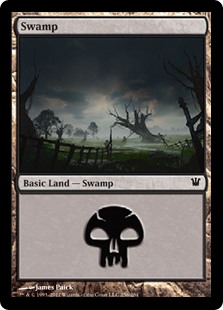
Fittingly, the spooky plane of Innistrad gives us an uncanny Swamp—a settled place, a civilized place, but one where water seeps up into your footprints, and you find unsettling artifacts when you dig deeper than a couple of feet.
Swamp #238, Magic 2013:
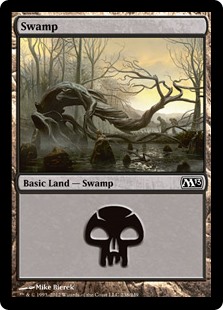
Not a hellish place, just an overgrown one, through which travelers pass. Nice, basic swamp—hinterlands, not outright predatory.
Swamp #293, Lorwyn:
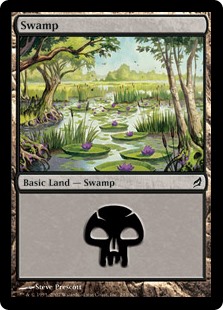
Swamps can be pastoral places, too—planes of water and vegetation, shady groves, beds of flowers. I feel like I’ve been here before.
Swamp #340, Odyssey:
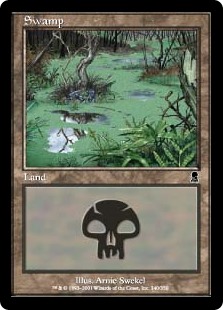
Speaking of, this legitimately looks like the South Carolina Lowcountry. Absolutely terrifying, the first time you realize what looks like perfectly flat grass is, in fact, duck grass skimming over deep water. You can disappear without a ripple in the swamps, be swallowed up entirely.
Swamp #261, Amonkhet:
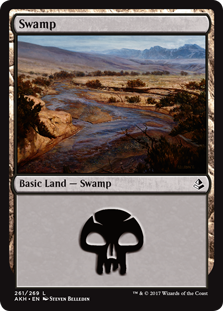
Really peaceful, with a human imprint upon a natural landscape. Amonkhet doesn’t get the respect it deserves for some truly stunning lands, all of which represent human civilization clinging on in a hostile world—later somewhat spoiled by the apocalyptic lands of Hour of Devastation. Until that point, though, this is a swamp that borders a port or a major city—a cosmopolitan swamp.
Bonus: Best Swamp Commanders
The Gitrog Monster: Nothing more Swamp-like than a massive frog who consumes land (which I’ve always seen as devouring species), who is toxic, and is the size of three bears stapled together. Until they make a Lizard Man, this is the Swampiest.
Korlash, Heir to Blackblade: The text box speaks for itself.
Sima Yi, Wei Field Marshal: Basically Francis Marion himself, this old fella’s half a Korlash—but it’s the important half.
Gallowbraid & Morinfen: More than any other Legend, these boys look like they evolved in swamps—there’s a reptilian-but-smooth cast to them, a monstrous humanity to their faces. These are the swamp-dwellers of British folklore. These are predators.
Seizan, Perverter of Truth: He looks like a horrifying but vital part of the swamp’s ecosystem, like a dead deer got partially devoured by fungus, then decided to get up and wander around. Amazing. Disgusting. Also a lot of fun in Commander.
As a final recommendation: get down in the muck. Find yourself a nearby swamp, a guide, and a notebook, and spend a morning strolling. Black, if we listen to Wizards marketing, loves power above all else—and there’s a great natural power in the swamps. Last month, I drove out to the Congaree Swamp to watch the fireflies congregate. Each June, after they mature, they gather in the groves and blink in unison to attract mates. If you go and stand in the dark, eventually you lose perspective, grow disoriented by the points of light, drifting and flickering and swarming in sidereal clusters. Fireflies are beautiful (and highly toxic to predators), and they’ve always been a core part of my summers—from the ones that would dawdle through the air of my suburban home growing up, to the wilder knots of them that flare in frustrated concupiscence.
One of the earliest definitions of “nostalgia,” from 1833’s Cyclopaedia of Practical Medicine, follows: “The concourse of depressing symptoms which sometimes arise in persons who are absent from their native country, when they are seized with a longing desire of returning to their home and friends and the scenes of their youth.” It makes me wonder if I’m a black mage because I love swamps, or if I love swamps because I’m a black mage. Like most parallel-constructed navel-gazing, it doesn’t much matter which came first: what matters is that I have a place in the swamps, whether it’s the Congaree or Takenuma—and so do you. Black mana is selfless in its corruptibility—by making you a part of the swamp, it wants you to become powerful. Why fight it?
A lifelong resident of the Carolinas and a graduate of the University of North Carolina, Rob has played Magic since he picked a Darkling Stalker up off the soccer field at summer camp. He works for nonprofits as an educational strategies developer and, in his off-hours, enjoys writing fiction, playing games, and exploring new beers.

